Major Traffic Laws of Florida (Part 3)
Basic driving laws. Explain the concepts of speed adjustment in relation to surroundings, including school and construction zones, speeding laws and adjusting your speed to be appropriate for existing conditions.
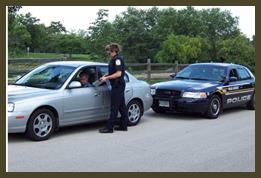 Speeding is illegal, and speeding and driving under the influence (DUI) are the largest contributing factors in fatal crashes. Speeding is illegal. Every driver knows that traveling faster than the posted speed limit is against the law, and yet, speeding is the leading cause of traffic tickets. Many drivers speed. Do you know people who drive over the speed limit? Are you going to be one of those drivers who breaks the law by driving faster than the posted speed limit?
Speeding is illegal, and speeding and driving under the influence (DUI) are the largest contributing factors in fatal crashes. Speeding is illegal. Every driver knows that traveling faster than the posted speed limit is against the law, and yet, speeding is the leading cause of traffic tickets. Many drivers speed. Do you know people who drive over the speed limit? Are you going to be one of those drivers who breaks the law by driving faster than the posted speed limit?
In general, Americans are law abiding citizens; usually we do not break the law. Most people do not shoplift, do not sell drugs, and do not blatantly run through red lights. However, many people break the law by speeding, and speeding can lead to fatal results.1
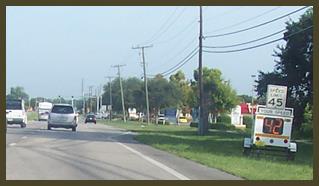 Is it illegal to drive just one mile per hour over the speed limit? Technically, yes, it is illegal. However, unless you are driving in a school zone, speeding citations are not written until you are traveling at least six miles per hour over the posted speed limit. With this knowledge in mind, some drivers attempt to maintain speeds that are exactly five miles per hour above the speed limit. This practice is unsafe and can easily result in traffic citations. It is incredibly difficult to maintain an exact speed while driving a car, even when using the car’s cruise control. Speeds easily drift one or two miles per hour above and below your desired speed. If you always attempt to drive exactly five miles per hour above the posted speed limit and exceed your target speed by just one mile per hour, you will be ticketed and will be required to pay fines and assessments of about $125, depending on the county where you live. The fine is $25, and additional assessments and fees are approximately $100 depending on the county. If you always attempt to drive five miles per hour over the posted speed limit and exceed your desired speed by five miles per hour, you will be ticketed and will be required to pay fines and assessments of about $200. The fine for traveling 10-14 miles per hour over the speed limit is $100, and, once again, additional assessments and fees will add about $100. The simple solution—just drive the speed limit! It is safer and much less expensive. (s.318.18, F.S.)
Is it illegal to drive just one mile per hour over the speed limit? Technically, yes, it is illegal. However, unless you are driving in a school zone, speeding citations are not written until you are traveling at least six miles per hour over the posted speed limit. With this knowledge in mind, some drivers attempt to maintain speeds that are exactly five miles per hour above the speed limit. This practice is unsafe and can easily result in traffic citations. It is incredibly difficult to maintain an exact speed while driving a car, even when using the car’s cruise control. Speeds easily drift one or two miles per hour above and below your desired speed. If you always attempt to drive exactly five miles per hour above the posted speed limit and exceed your target speed by just one mile per hour, you will be ticketed and will be required to pay fines and assessments of about $125, depending on the county where you live. The fine is $25, and additional assessments and fees are approximately $100 depending on the county. If you always attempt to drive five miles per hour over the posted speed limit and exceed your desired speed by five miles per hour, you will be ticketed and will be required to pay fines and assessments of about $200. The fine for traveling 10-14 miles per hour over the speed limit is $100, and, once again, additional assessments and fees will add about $100. The simple solution—just drive the speed limit! It is safer and much less expensive. (s.318.18, F.S.)
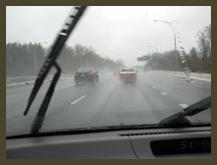 Approximately 30% of fatal crashes involve speeding. Speeding is defined as driving over the speed limit, racing, or driving too fast for roadway conditions. In other words, if driving conditions are not “good” because the road is wet, or it is foggy, or congestion is slowing traffic, drivers should slow to a speed that is reasonable and prudent for those conditions. The great majority of speeding-related fatalities occur on roads not designated as interstate highways. At least interstate highways are built for speed; they are straight and do not have intersections. Non-interstate roadways are not compatible with higher speeds and consequently host most of our fatal speeding-related crashes.2
Approximately 30% of fatal crashes involve speeding. Speeding is defined as driving over the speed limit, racing, or driving too fast for roadway conditions. In other words, if driving conditions are not “good” because the road is wet, or it is foggy, or congestion is slowing traffic, drivers should slow to a speed that is reasonable and prudent for those conditions. The great majority of speeding-related fatalities occur on roads not designated as interstate highways. At least interstate highways are built for speed; they are straight and do not have intersections. Non-interstate roadways are not compatible with higher speeds and consequently host most of our fatal speeding-related crashes.2
The combination of alcohol and speeding is especially dangerous, and speeding is a leading factor in alcohol-related crashes. In fatal crashes where speed is a factor, about half of the speeding drivers have also been drinking. This helps to explain why the small percentage of total crashes (fender benders to fatalities) that are alcohol-related end up killing so many of the people who die each year on our highways.1,2
The statistics we’ve reviewed clearly tell us that speeding should be avoided as it makes driving much more dangerous. However, simple observation of the traffic on our roadways tells us that many drivers are speeding, and speeding is the leading cause for traffic tickets. At an intellectual level, it is easy to accept that speeding is dangerous. If you are speeding:2
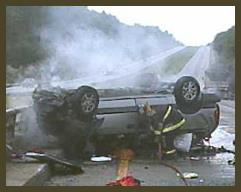 You have less time to see danger and react.
You have less time to see danger and react.- Your stopping distance is greater. If you double your speed, your distance required for braking will be four times longer.
- You are more likely to skid or roll over in a turn.
- Your force of impact in a collision is much greater. A 25 mile per hour crash into a fixed object generates a lot of force and can cause significant injury. By increasing your driving speed by only 10 miles per hour to 35 miles per hour, the force of impact doubles.
- You are more likely to be injured or killed in a collision.
Apparently many drivers do not believe speeding is dangerous because if they did, they would not be doing it. We do not have a large population of motorcycle riders, or sky divers, or bungee jumpers in our country because people understand that these activities are very dangerous, and most people do not like placing their lives at risk. But we have a lot of speeders. Why do people speed? Here are some of the most common excuses:
 It’s not that dangerous.
It’s not that dangerous.- I won’t get caught.
- Lots of people speed.
- Speed limits are too low.
- I just go with the flow, even if the flow is speeding.
- Speeding is fun.
- I’m always running late; speeding helps me to arrive on time.
Let’s examine these reasons for exceeding the speed limit:
- It’s not that dangerous. Speeding is a leading cause of fatal crashes; about 30% of fatal crashes involve speeding. Teen drivers involved in fatal crashes are more likely to be speeding than drivers who are the ages of their parents or grandparents. Remember, in addition to killing themselves, teen drivers kill their passengers, the occupants of other vehicles, bicycle riders, and pedestrians as well.
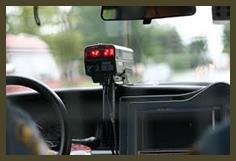 I won’t get caught. Speeding is the leading cause of traffic citations. People do get caught for speeding. In addition to paying the speeding fine, speeding tickets may cause insurance companies to raise insurance rates, especially for young drivers.
I won’t get caught. Speeding is the leading cause of traffic citations. People do get caught for speeding. In addition to paying the speeding fine, speeding tickets may cause insurance companies to raise insurance rates, especially for young drivers.
- Lots of people speed. Going along with the crowd has never been a good excuse for bad behavior, especially for unsafe bad behavior. Lots of people do things they should not do, including things that are illegal. Unfortunately, many people, especially young people, are influenced by peer pressure. Teens drink and use drugs, and many teens speed. Do you go along with the crowd or do you do the right thing?
- Speed limits are too low. Speed limits are set by traffic engineers and law makers who consider many factors like the type of roadway, congestion, and the crash history of the road segment.
- I just go with the flow, even if the flow is speeding. Drivers should attempt to drive with the flow of traffic, but keeping up with the traffic flow is no excuse for speeding. On the other hand, if driving conditions are good, driving slower than the speed limit can cause danger as drivers behind you will become frustrated and may attempt to pass even though the driving conditions may not permit safe passing.
 Speeding is fun. Driving is not the place to look for thrills. If you are looking for excitement, go sky diving or rock climbing, or try out for an athletic team, or join the debate club, or enlist in the military. If you are seeking thrills, pursue thrilling activities that do not place the lives of others at risk. It is very selfish for thrill-seekers to get their kicks by risking the lives of others, which is what happens when a person speeds on our highways.
Speeding is fun. Driving is not the place to look for thrills. If you are looking for excitement, go sky diving or rock climbing, or try out for an athletic team, or join the debate club, or enlist in the military. If you are seeking thrills, pursue thrilling activities that do not place the lives of others at risk. It is very selfish for thrill-seekers to get their kicks by risking the lives of others, which is what happens when a person speeds on our highways.
- I’m always running late; speeding helps me to arrive on time. For most of our travels, speeding actually saves very little time. The following chart demonstrates this point:
Let’s examine the amount of time saved by driving over the speed limit. In addition to being illegal and more dangerous, this chart shows that speeding saves very little time.
| SPEED | TIME TO GO 5 MILES | TIME TO GO 10 MILES | TIME TO GO 20 MILES |
| 70 mph | 4 min, 16 sec | 8 min, 34 sec | 17 min, 10 sec |
| 60 mph | 5 min | 10 min | 20 min |
| 50 mph | 6 min | 12 min | 24 min |
| 40 mph | 7 min, 30 sec | 15 min | 30 min |
| 30 mph | 10 min | 20 min | 40 min |
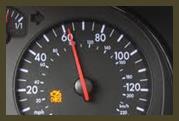 Increasing your speed from 50 to 60 mph on your way to work or school will save only one minute if the trip is five miles, as this speeding reduces your travel time from six minutes to five minutes. When you consider that there are 1,440 minutes in a day, taking an additional minute or two to arrive at your destination is not that big of a deal.
Increasing your speed from 50 to 60 mph on your way to work or school will save only one minute if the trip is five miles, as this speeding reduces your travel time from six minutes to five minutes. When you consider that there are 1,440 minutes in a day, taking an additional minute or two to arrive at your destination is not that big of a deal.
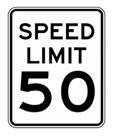 Increasing your speed from 50 to 60 mph will save only two minutes if the trip is 10 miles, and four minutes if the trip is 20 miles. When you consider the small amount of time saved, it just doesn’t make sense to speed and to risk a crash or an expensive traffic ticket.
Increasing your speed from 50 to 60 mph will save only two minutes if the trip is 10 miles, and four minutes if the trip is 20 miles. When you consider the small amount of time saved, it just doesn’t make sense to speed and to risk a crash or an expensive traffic ticket.
It is important to realize that the chart above assumes perfect driving conditions. In other words, the chart assumes that you will not be slowed down by traffic lights or traffic congestion. Drivers who abide by speed limits often find themselves stopped at traffic lights alongside speeders who passed them on the way to the intersection. How many times have you seen a driver speed by or cut in and out of traffic only to end up next to you at the next traffic signal? Or have you ever passed a vehicle and then noted later that the vehicle is right behind you when you stop at a traffic light farther down the road?
Consider this scenario, you depart for work 10 minutes late, and your work site is 10 miles from home. Because you are running late, you decide to drive 10 miles per hour over the speed limit. At best, assuming you encounter no red lights or traffic congestion, your speeding would save only two minutes; you would still end up being eight minutes late. If you need to be somewhere on time, then you must leave on time.
When driving, you should stay in the right lane, or lanes, unless you are passing. The right lane, or lanes, is for driving, and the left lane is for passing. One of the benefits of driving the speed limit is that you will most likely be able to do so while remaining in the right lane, or lanes, of traffic.
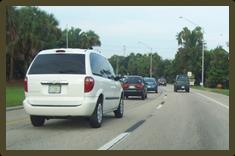 If traffic is congested, often all lanes are traveling at about the same speed. In this case, consider staying in the right lane as moving to the passing lane will not save much time. If a 10 mile per hour speed differential saved two minutes in the previous example, then picking up an extra three or four miles per hour would save very little time.
If traffic is congested, often all lanes are traveling at about the same speed. In this case, consider staying in the right lane as moving to the passing lane will not save much time. If a 10 mile per hour speed differential saved two minutes in the previous example, then picking up an extra three or four miles per hour would save very little time.
It is against the law to exceed the speed limit in order to pass another vehicle. In general, a timely pass requires that the passing car be traveling at least five miles per hour faster than the car being passed. Therefore, you should only consider passing if the vehicle ahead is traveling at least five miles per hour below the speed limit. Also, consider that most drivers do not precisely hold their speeds. Therefore, if the driver ahead is going just a few miles per hour below the speed limit when you start your pass, by the time you pull up next to the vehicle, he/she might be going a few miles per hour over the speed limit; completing your pass would require you to break the law. Many times a little patience will prevent needless lane changes and passing maneuvers.
Once again, traffic lights and traffic congestion often reduce the small amount of time saved by speeding.
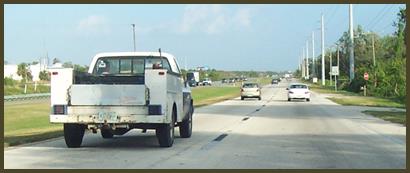
For example, the white pickup truck above is speeding by in the passing lane.
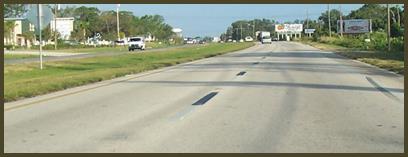
Shortly thereafter, the white pickup truck is a half mile ahead of the vehicle in the right lane.
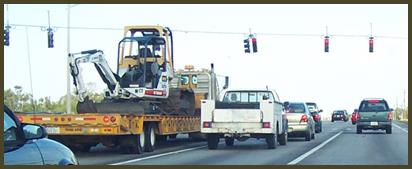
However, several traffic lights later, the vehicle in the right lane and the white pickup truck are back together again.
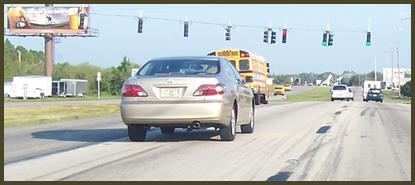
Similarly, in the picture above you can see that the gold sedan in the passing lane is speeding by a driver in the right lane.
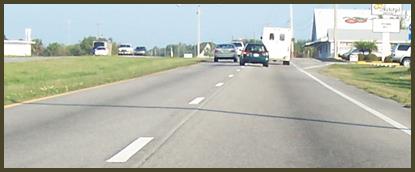
The gold sedan is held up by traffic congestion but eventually passes this group of vehicles as well.
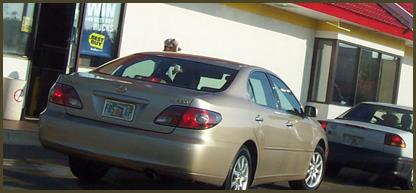
However, in the bottom picture, the gold sedan and the first vehicle that was passed are back together again, in line at a fast food window. The driver in the gold car was speeding to get to a fast food restaurant!
We hope that you are beginning to agree that speeding does not really save much time. It is also important to realize that most of us only have one or two commitments per day that require us to arrive at a destination at a specific time.  We are required to arrive on-time to school or work and to scheduled appointments. The rest of our trips usually have no required arrival times. When we drive home from school, or when we go shopping or out to eat, there is no required arrival time; therefore, it makes no sense to speed when making these trips. For those infrequent trips that have a required arrival time, you must leave with enough time to permit you to get to your destination without speeding. Let’s think a little more about this.
We are required to arrive on-time to school or work and to scheduled appointments. The rest of our trips usually have no required arrival times. When we drive home from school, or when we go shopping or out to eat, there is no required arrival time; therefore, it makes no sense to speed when making these trips. For those infrequent trips that have a required arrival time, you must leave with enough time to permit you to get to your destination without speeding. Let’s think a little more about this. 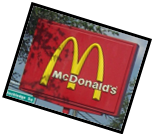 Sometimes, even for trips with required arrival times, being a little late is not that big of a deal. Trips to doctor appointments have required arrival times, but usually being a little late won’t cause a big problem. After all, many times you have to wait past your appointment time, even if you arrive early! How about going to church? If you arrive late for church, even considerably late, you are not going to be sent home, right?
Sometimes, even for trips with required arrival times, being a little late is not that big of a deal. Trips to doctor appointments have required arrival times, but usually being a little late won’t cause a big problem. After all, many times you have to wait past your appointment time, even if you arrive early! How about going to church? If you arrive late for church, even considerably late, you are not going to be sent home, right?
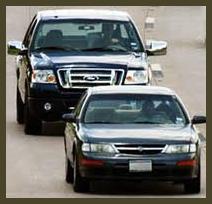 Consider this true story about the driver of a shiny black pickup truck who was speeding to get to a destination with no required arrival time, a shopping trip to a local discount store. The driver of the pickup closed rapidly on the back bumper of the vehicle ahead that was traveling at the speed limit in the right lane of traffic. The driver of the pickup was initially unable to pass because there were no openings in the heavy traffic in the left lane so he tailgated the driver ahead for about a block. When traffic on his left opened up just enough for him to pass, the driver of the pickup jerked his vehicle into the left lane, charged by the car he had been tailgating, swerved back in front of that vehicle, accelerated rapidly ahead for about a hundred yards, then braked hard and made a sharp right turn into the discount store’s parking lot. A few seconds later, the driver he had just passed, the driver he had been tailgating, turned into the discount store’s parking lot as well, parked his car, and started walking to the store entrance. As the driver of the car who had been going the speed limit walked into the store, the driver of the shiny black pickup was still sitting in his vehicle waiting for a parking spot to open up near the front of the store. The law abiding driver ended up walking into the store ahead of the driver who had been speeding and driving so aggressively.
Consider this true story about the driver of a shiny black pickup truck who was speeding to get to a destination with no required arrival time, a shopping trip to a local discount store. The driver of the pickup closed rapidly on the back bumper of the vehicle ahead that was traveling at the speed limit in the right lane of traffic. The driver of the pickup was initially unable to pass because there were no openings in the heavy traffic in the left lane so he tailgated the driver ahead for about a block. When traffic on his left opened up just enough for him to pass, the driver of the pickup jerked his vehicle into the left lane, charged by the car he had been tailgating, swerved back in front of that vehicle, accelerated rapidly ahead for about a hundred yards, then braked hard and made a sharp right turn into the discount store’s parking lot. A few seconds later, the driver he had just passed, the driver he had been tailgating, turned into the discount store’s parking lot as well, parked his car, and started walking to the store entrance. As the driver of the car who had been going the speed limit walked into the store, the driver of the shiny black pickup was still sitting in his vehicle waiting for a parking spot to open up near the front of the store. The law abiding driver ended up walking into the store ahead of the driver who had been speeding and driving so aggressively.
This true story is repeated many times every day as drivers speed to get to destinations with no required arrival time. We all understand why an ambulance driver goes over the speed limit at times. After all, the ambulance driver is trying to transport someone to the hospital as fast as possible. But why do so many other people speed when the speeding is so senseless? In addition to our Traffic Law and Substance Abuse Education Course, Wise Traffic School offers the Basic Driver Improvement (BDI) course for drivers who have received traffic citations and do not want points added to their driving record. Our school surveyed 600 BDI students to learn where they were going when they received their traffic citations. Two-thirds of those surveyed who were ticketed for speeding were going home, or going shopping, or going to some other destination with no required arrival time. Consider this scenario: you speed on the way home, walk into your house, immediately click on your TV, and you hear the familiar music from a frequently run commercial. If you had driven the speed limit on the way home, entered your home and clicked on the TV, the commercial would have been ending. That’s about all the time speeding saves on most trips—the time allotted for a TV commercial.
Do not speed. If you are driving to school or work or to a scheduled appointment, leave with plenty of time to arrive at your destination without speeding. For the remainder of your trips, the majority of which do not have required arrival times, drive the speed limit!
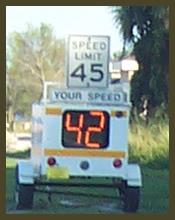 When setting maximum or minimum speed limits, numerous factors are considered: road type and layout, driving conditions, traffic congestion, restrictions to visibility, and crash history. Drivers may go no faster than posted maximum speed limits and may go no slower than posted minimum speed limits unless conditions make it dangerous to travel at the minimum speed. If conditions dictate, more restrictive speed limits may be set for designated sections of a roadway, and “Speed Zone” signs may warn motorists of these upcoming reduced speed limits. Drivers must slow to the posted speed limit by the time the speed limit sign is reached. If you are approaching a sign for a higher speed zone ahead, you are not permitted to speed up to the higher speed until you pass the higher speed limit sign. Also, advisory speed limits, posted on yellow signs, provide speed guidelines for limited times like curves and exit ramps.3
When setting maximum or minimum speed limits, numerous factors are considered: road type and layout, driving conditions, traffic congestion, restrictions to visibility, and crash history. Drivers may go no faster than posted maximum speed limits and may go no slower than posted minimum speed limits unless conditions make it dangerous to travel at the minimum speed. If conditions dictate, more restrictive speed limits may be set for designated sections of a roadway, and “Speed Zone” signs may warn motorists of these upcoming reduced speed limits. Drivers must slow to the posted speed limit by the time the speed limit sign is reached. If you are approaching a sign for a higher speed zone ahead, you are not permitted to speed up to the higher speed until you pass the higher speed limit sign. Also, advisory speed limits, posted on yellow signs, provide speed guidelines for limited times like curves and exit ramps.3
Speed limits establish maximum and minimum speeds for good conditions. If, for example, the road is wet and it is not safe to drive at the speed limit, drivers are required to slow to a safe speed. Other examples of driving conditions that would require slowing below the posted speed limit would include bad road conditions, pedestrians on or near the roadway, and traffic congestion. The Florida Statutes state that “no person shall drive a vehicle on a highway at a speed greater than is reasonable and prudent under the conditions and having regard to the actual and potential hazards then existing. In every event, speed shall be controlled to avoid colliding with any person, vehicle, or other conveyance or object,” and drivers should exercise “due care.” (s. 316.183, F.S.)3,4
Similar to speeding, driving too slowly can also be very dangerous. Drivers should drive with the flow of traffic (within the speed limit) and avoid blocking vehicles that are behind them. If you drive in the passing lane when you are not passing, or if you are driving in the passing lane and blocking faster traffic, drivers behind you may become frustrated. Frustrated drivers sometimes make dangerous lane changes that increase risk for you and those who share the road with you.5
The maximum posted speed limits allowed by law on Florida roadways are detailed in the table below. Of course, lower speed limits are often posted on these roadways. (s. 316.183, F.S.)
| AREAS | SPEED LIMIT |
| Limited access highways | 70 mph |
| Four lane highways divided by a median | 65 mph |
| Other roadways | 60 mph |
If a speed limit is not posted, the Florida Statutes specify maximum and minimum speed limits as follows (s. 316.183, F.S.):
| AREAS | SPEED LIMIT |
| Business or Residential Districts (Note: Counties or municipalities may set residential limits at 20 or 25 mph if a speed limit is not posted.) |
30 mph |
| All other locations if a speed limit is not posted | 55 mph |
| Interstate Highways with not less than 4 lanes If Speed Limit 70 mph |
40 mph minimum 50 mph minimum |
The fines for speeding specified in the Florida Statutes are detailed in the table below. *Please note that counties add additional fees of about $100 to these fines. (s. 318.18, F.S.)
| MPH OVER SPEED LIMIT | Fine* |
| 1-5 | Warning |
| 6-9 | $25 |
| 10-14 | $100 |
| 15-19 | $150 |
| 20-29 | $175 |
| 30 and above | $250 and Mandatory Court Appearance |
School and Construction Zones
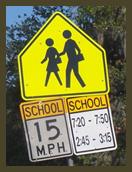 Speeding in school and construction zones is treated very seriously. The Florida Statutes specify that speeding by 5 mph or less in a school zone will result in a fine of $50. For speeding violations above 5 mph, speeding fines are doubled. Florida law allows counties and municipalities to install camera-equipped radar detection devices to enforce speed limits in school zones. A notice of the violation and fine will be sent to the registered owner of the vehicle, and, if the fine is not paid by the due date, a moving violation citation will be issued, and points will be assessed to the registered owner’s driver license. In construction zones, if construction workers are present or operating equipment, speeding fines are doubled as well. (s. 318.18, F.S.; s. 316.008, F.S.)
Speeding in school and construction zones is treated very seriously. The Florida Statutes specify that speeding by 5 mph or less in a school zone will result in a fine of $50. For speeding violations above 5 mph, speeding fines are doubled. Florida law allows counties and municipalities to install camera-equipped radar detection devices to enforce speed limits in school zones. A notice of the violation and fine will be sent to the registered owner of the vehicle, and, if the fine is not paid by the due date, a moving violation citation will be issued, and points will be assessed to the registered owner’s driver license. In construction zones, if construction workers are present or operating equipment, speeding fines are doubled as well. (s. 318.18, F.S.; s. 316.008, F.S.)
In school zones, drivers must use caution, watching out for children walking, running, and riding bicycles and for the increased traffic congestion associated with getting students to and from school. Remember that children can be very unpredictable.3,6,7
 Five-sided, yellow school signs and school crossing signs alert drivers to an upcoming school zone. Also, school crossing guards warn that a school is near. Follow the directions of school crossing guards, and if you are required to stop, be sure to stop short of crosswalks. If there is a flashing yellow light announcing that a school zone speed limit is in effect or if you are in a school zone during the time period specified on the speed limit sign, you must follow posted school zone speed limits. If you are driving just 1 mph over the speed limit, a traffic citation for speeding can be issued. Fines are doubled for speeding in school zones. (s. 318.18, F.S.)
Five-sided, yellow school signs and school crossing signs alert drivers to an upcoming school zone. Also, school crossing guards warn that a school is near. Follow the directions of school crossing guards, and if you are required to stop, be sure to stop short of crosswalks. If there is a flashing yellow light announcing that a school zone speed limit is in effect or if you are in a school zone during the time period specified on the speed limit sign, you must follow posted school zone speed limits. If you are driving just 1 mph over the speed limit, a traffic citation for speeding can be issued. Fines are doubled for speeding in school zones. (s. 318.18, F.S.)
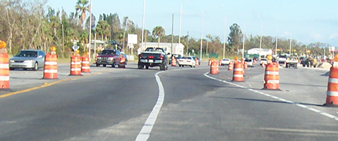 When driving in construction zones and work areas, you must be alert to road hazards, required stops, lane changes, construction workers, vehicles, and equipment. Slow down when approaching construction and work zones, and follow the directions and speed limits provided by signs, flashing arrow panels, flagmen/women, and police officers. Most construction and maintenance signs are orange and diamond-shaped to indicate a warning of possible hazard. Also, expect to be directed by various channeling devices to include barricades, vertical panels, drums, and cones. At night, these channeling devices may be equipped with warning lights. Use extreme caution, especially at night, as required lane changes and detours can be confusing.6,8
When driving in construction zones and work areas, you must be alert to road hazards, required stops, lane changes, construction workers, vehicles, and equipment. Slow down when approaching construction and work zones, and follow the directions and speed limits provided by signs, flashing arrow panels, flagmen/women, and police officers. Most construction and maintenance signs are orange and diamond-shaped to indicate a warning of possible hazard. Also, expect to be directed by various channeling devices to include barricades, vertical panels, drums, and cones. At night, these channeling devices may be equipped with warning lights. Use extreme caution, especially at night, as required lane changes and detours can be confusing.6,8
Drivers who exceed the speed limit in construction zones are a hazard to construction workers and other drivers as well. Fines are doubled for speeding in a construction zone if workers are present or if equipment is being operated. If workers are not present, drivers must still obey the posted speed limit when traveling through a construction zone. (s. 318.18, F.S.)
Signs, signals and road markings, including interpretation of centerlines, crosswalks, bike lanes, turn lanes, flashing lights and proper responses to phases of traffic signals, stop and yield signs
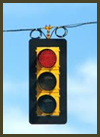 Traffic control signals are used to manage traffic at intersections, and must be obeyed by drivers, pedestrians, and bicycle riders unless there is an officer directing traffic.
Traffic control signals are used to manage traffic at intersections, and must be obeyed by drivers, pedestrians, and bicycle riders unless there is an officer directing traffic.  To assist colorblind drivers, the red light is always on top for upright signals and is the left light for horizontal signals. The following traffic signals at intersections must be followed:3,6,9
To assist colorblind drivers, the red light is always on top for upright signals and is the left light for horizontal signals. The following traffic signals at intersections must be followed:3,6,9
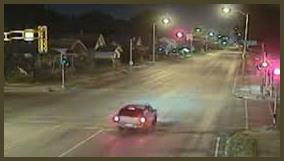 Red Light: Running a red light is one of the most dangerous and irresponsible things a driver can do. If you are driving the vehicle nearest the traffic signal, come to a complete stop at the marked stop line or before moving into the crosswalk or intersection. Remember that some signals are set to change only when a vehicle is at the stop line.
Red Light: Running a red light is one of the most dangerous and irresponsible things a driver can do. If you are driving the vehicle nearest the traffic signal, come to a complete stop at the marked stop line or before moving into the crosswalk or intersection. Remember that some signals are set to change only when a vehicle is at the stop line. 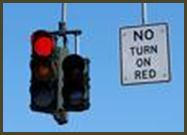 After coming to a complete stop, drivers may turn right on red if the intersection is clear of vehicles and pedestrians unless a “NO TURN ON RED” sign is present. Do not turn right on red if a "NO TURN ON RED" sign is displayed. Left turns on red from a one-way street onto another one-way street are also allowed. A person who receives a traffic ticket for a red light violation must attend a 4-hour Basic Driver Improvement Course to avoid cancellation of his/her driver license. The fine for failing to stop at a traffic signal is $125 plus additional county fees. (s. 316.075, F.S.; 318.18(14), F.S.)
After coming to a complete stop, drivers may turn right on red if the intersection is clear of vehicles and pedestrians unless a “NO TURN ON RED” sign is present. Do not turn right on red if a "NO TURN ON RED" sign is displayed. Left turns on red from a one-way street onto another one-way street are also allowed. A person who receives a traffic ticket for a red light violation must attend a 4-hour Basic Driver Improvement Course to avoid cancellation of his/her driver license. The fine for failing to stop at a traffic signal is $125 plus additional county fees. (s. 316.075, F.S.; 318.18(14), F.S.)
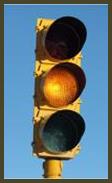 Yellow Light: The yellow light indicates that the red stop light is about to illuminate. If you are approaching a yellow light, do not enter the intersection if you can safely stop without driving through it. Do not accelerate in an attempt to get into the intersection before the light changes to red. Once you accelerate in an attempt to beat the red light, you will be committed to going through the intersection and could find yourself running a red light. If a driver on the crossing roadway immediately moves into the intersection when his/her traffic signal changes from red to green and that driver fails to check for your oncoming vehicle, a deadly crash may occur. The yellow light is designed to permit drivers to clear the intersection when you are already driving through it. Of course, if you are unable to safely stop and must drive through the intersection, do so with extreme caution. (s. 316.075, F.S.)
Yellow Light: The yellow light indicates that the red stop light is about to illuminate. If you are approaching a yellow light, do not enter the intersection if you can safely stop without driving through it. Do not accelerate in an attempt to get into the intersection before the light changes to red. Once you accelerate in an attempt to beat the red light, you will be committed to going through the intersection and could find yourself running a red light. If a driver on the crossing roadway immediately moves into the intersection when his/her traffic signal changes from red to green and that driver fails to check for your oncoming vehicle, a deadly crash may occur. The yellow light is designed to permit drivers to clear the intersection when you are already driving through it. Of course, if you are unable to safely stop and must drive through the intersection, do so with extreme caution. (s. 316.075, F.S.)
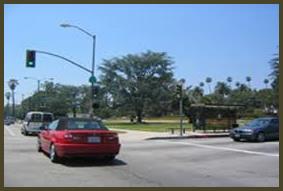 Green Light: When the light changes to green, drivers may travel through the intersection, or turn left or right unless a sign prohibits turning, but only if the intersection is clear of vehicles and pedestrians. When making a left turn without a turn arrow, you must yield to oncoming traffic before turning. When approaching an intersection, always be on the lookout for possible red light runners and be on guard for oncoming drivers who may attempt to make left turns in front of you. In addition, if you are approaching an intersection where the green light has been illuminated for a while, expect that the light might change to yellow. If following another vehicle, check your following distance and be ready for the vehicle ahead of you to stop if the light changes to yellow. (s. 316.075, F.S.)
Green Light: When the light changes to green, drivers may travel through the intersection, or turn left or right unless a sign prohibits turning, but only if the intersection is clear of vehicles and pedestrians. When making a left turn without a turn arrow, you must yield to oncoming traffic before turning. When approaching an intersection, always be on the lookout for possible red light runners and be on guard for oncoming drivers who may attempt to make left turns in front of you. In addition, if you are approaching an intersection where the green light has been illuminated for a while, expect that the light might change to yellow. If following another vehicle, check your following distance and be ready for the vehicle ahead of you to stop if the light changes to yellow. (s. 316.075, F.S.)
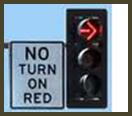 Red Arrow: The red arrow indicates that traffic is not permitted to go in the direction of the arrow. After coming to a complete stop for an illuminated red arrow to the right, drivers may turn right if the intersection is clear of vehicles and pedestrians unless a “NO TURN ON RED” sign is present.
Red Arrow: The red arrow indicates that traffic is not permitted to go in the direction of the arrow. After coming to a complete stop for an illuminated red arrow to the right, drivers may turn right if the intersection is clear of vehicles and pedestrians unless a “NO TURN ON RED” sign is present.
- Yellow Arrow: Drivers should stop if possible. The yellow arrow appears after a green arrow to indicate that the light is about to change to red. If you are planning a left or right turn at an intersection, you should slow to a speed that will permit a safe 90 degree turn; this slow speed will usually permit you to make a safe stop once the turn arrow changes from green to yellow unless you are very close to entering the intersection.
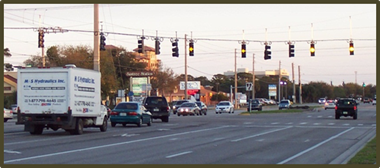 Instead of stopping when the yellow turn arrow illuminates, some drivers continue entering the intersection until the turn arrow changes to red; this practice may cause delay for drivers waiting to enter the intersection from the crossing roadway who now have a green light. In the picture above, there are three vehicles in the left turn lane. The first vehicle was about to enter the intersection when the yellow turn arrow illuminated and appropriately entered the intersection to make a left turn. The last two vehicles in the left turn lane should stop as they are traveling slowly and can safely stop before entering the intersection.
Instead of stopping when the yellow turn arrow illuminates, some drivers continue entering the intersection until the turn arrow changes to red; this practice may cause delay for drivers waiting to enter the intersection from the crossing roadway who now have a green light. In the picture above, there are three vehicles in the left turn lane. The first vehicle was about to enter the intersection when the yellow turn arrow illuminated and appropriately entered the intersection to make a left turn. The last two vehicles in the left turn lane should stop as they are traveling slowly and can safely stop before entering the intersection.
- Flashing Yellow Arrow: Drivers may cautiously turn in the direction of the arrow after yielding to oncoming traffic and pedestrians. Oncoming traffic has a green light.9
- Green Arrow: If you are driving in a lane with a green arrow pointing right or left, you must go in the direction signaled by the arrow. Be sure the intersection is clear of vehicles and pedestrians. (s. 316.075, F.S.)
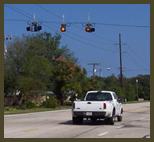 Flashing Red Light: Drivers must come to a complete stop. A flashing red light carries the same meaning as a stop sign and is used at dangerous intersections. (s. 316.076, F.S.)
Flashing Red Light: Drivers must come to a complete stop. A flashing red light carries the same meaning as a stop sign and is used at dangerous intersections. (s. 316.076, F.S.)
- Flashing Yellow Light: Drivers should slow down and proceed with caution. A flashing yellow light is used at or just before a dangerous intersection, or to alert you to a warning sign. (s. 316.076, F.S.)
Traffic signs – Standard Shapes, Colors, and Types4,6,9
There are three types of signs:
 Regulatory signs control traffic and give notice of laws or regulations that must be obeyed.
Regulatory signs control traffic and give notice of laws or regulations that must be obeyed.
 Warning signs alert or warn drivers of situations that might not be readily apparent
Warning signs alert or warn drivers of situations that might not be readily apparent
 Guide signs give directions. Examples are route designations, destinations, directions, distances, services, points of interest, and other geographical, recreational, or cultural information
Guide signs give directions. Examples are route designations, destinations, directions, distances, services, points of interest, and other geographical, recreational, or cultural information
Sign Colors
There are nine colors and nine shapes used for traffic signs. Each color and shape has an exact meaning that drivers should understand. Sign colors are described below:
| SIGN COLOR | MEANING | EXAMPLES |
| RED | Prohibition (ie., Do Not Enter, Wrong Way) |  |
| YELLOW | Warning |  |
| ORANGE | Temporary Traffic Control (ie., Construction, Maintenance) |  |
| WHITE with black or red lettering |
Regulatory: Give notice of traffic laws or regulations (ie., speed limit signs) |  |
| BLACK | Regulatory: Give notice of traffic laws of regulations | |
| YELLOW (or Fluorescent Yellow-Green) |
Used to indicate Pedestrian Warning, Bicycle Warning, School Bus or School Warning |  |
| BLUE | Motorist Services Guidance, Tourist Info, Evacuation Route Info |  |
| BROWN | Recreational and Cultural |  |
| GREEN | General Route Advice |  |
Sign Shapes
Sign shapes are described below:
| SIGN SHAPE | MEANING | EXAMPLES |
| OCTAGON (8 sides) |
Stop Signs Only |  |
| TRIANGLE (1 point down) |
Yield Signs Only |  |
| DIAMOND | Warning (notice of situation that might not be readily apparent) |  |
| PENTAGON (5 sides) |
School and School Crossing |  |
| CIRCLE | Highway-Railroad Crossing (advance warning), Evacuation Route |  |
| CROSS-BUCK | Highway-Railroad Crossing Only |  |
| PENNANT (horizontal triangle) |
No Passing Zone |  |
| RECTANGLE | Regulatory, Warning, and Guide (general service, specific service, and recreation signs) |  |
| TRAPEZOID (two sides parallel) |
Recreational |  |
Regulatory Signs
As noted earlier, regulatory signs give notice of traffic laws or regulations that must be obeyed. When you see a regulatory sign, you can add the words “I must” ahead of the directions on the sign. For example, “I must stop” or “I must yield.”3,6,9
 Stop Signs: Like red lights, stop signs must be obeyed. Stop signs are always octagonal (8-sided) and red with white letters and a white border. Drivers must come to a complete stop at a stop sign, or at the stop line by the sign, if a stop line is used. If there is no stop line, stop before entering the intersection. You should stop where you can visually clear the intersection and before any marked crosswalk. After stopping, and before proceeding, you must wait until the intersection is clear of vehicles or pedestrians and there is no oncoming traffic. A four-way stop sign means that there are four stop signs at this intersection. Traffic from all four directions must stop. The first vehicle to reach the intersection should move forward first. If two vehicles at ninety degree angles to each other reach the intersection at the same time, the driver on the left yields to the driver on the right. If two vehicles going in opposite directions reach the intersection at the same time, the driver going straight ahead should go first, and the driver turning left should yield. Be courteous and patient, move forward slowly to let other drivers see that you intend to drive through the intersection, and do not enter an intersection until it is clear.
Stop Signs: Like red lights, stop signs must be obeyed. Stop signs are always octagonal (8-sided) and red with white letters and a white border. Drivers must come to a complete stop at a stop sign, or at the stop line by the sign, if a stop line is used. If there is no stop line, stop before entering the intersection. You should stop where you can visually clear the intersection and before any marked crosswalk. After stopping, and before proceeding, you must wait until the intersection is clear of vehicles or pedestrians and there is no oncoming traffic. A four-way stop sign means that there are four stop signs at this intersection. Traffic from all four directions must stop. The first vehicle to reach the intersection should move forward first. If two vehicles at ninety degree angles to each other reach the intersection at the same time, the driver on the left yields to the driver on the right. If two vehicles going in opposite directions reach the intersection at the same time, the driver going straight ahead should go first, and the driver turning left should yield. Be courteous and patient, move forward slowly to let other drivers see that you intend to drive through the intersection, and do not enter an intersection until it is clear.
 Yield Signs: Yield signs have an inverted triangle shape, are white with a red border and red lettering, and are used where roads cross or merge. When approaching a yield sign, you should slow down and, if necessary, stop to give vehicles crossing your path the right-of-way. If the way is clear, you may move forward slowly without stopping. You are not yielding if you cause traffic in the lane you are entering or crossing to change speed.
Yield Signs: Yield signs have an inverted triangle shape, are white with a red border and red lettering, and are used where roads cross or merge. When approaching a yield sign, you should slow down and, if necessary, stop to give vehicles crossing your path the right-of-way. If the way is clear, you may move forward slowly without stopping. You are not yielding if you cause traffic in the lane you are entering or crossing to change speed.
Some additional examples of regulatory signs are shown below:
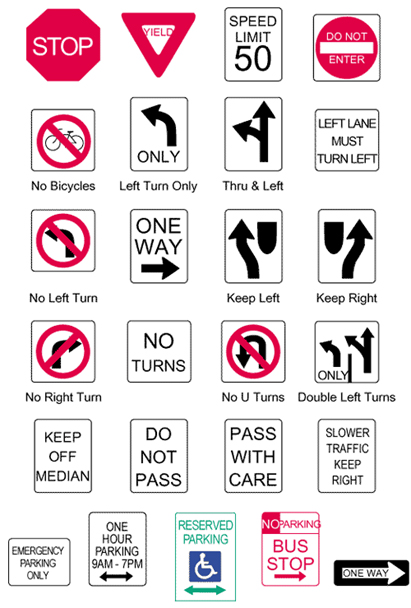
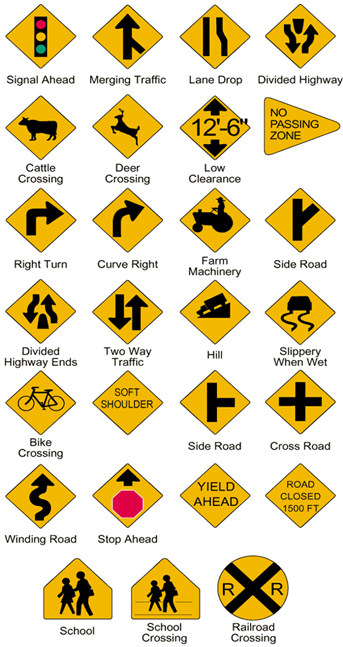 WARNING SIGNS
WARNING SIGNS
Most warning signs are yellow and diamond-shaped. These signs address a multitude of possible hazards ahead of your vehicle. Warning signs may use pictures, depictions, or words to describe the hazard ahead. When you see a warning sign, you can add the word “warning” before, and the word “ahead” after the picture, depiction, or words on the sign. For example, “warning slippery road ahead” or “warning stop ahead.” Some common warning signs are shown on the right.3,6,9
Let’s discuss a few warning signs in a little more detail:
 School Signs: School signs are yellow (or fluorescent yellow-green), five-sided signs that depict children carrying books, and school crossing signs show these students walking in a crosswalk. School signs indicate that you are near a school and may include speed limits with time
School Signs: School signs are yellow (or fluorescent yellow-green), five-sided signs that depict children carrying books, and school crossing signs show these students walking in a crosswalk. School signs indicate that you are near a school and may include speed limits with time 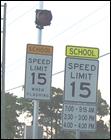 frames when the speed limits apply. You must follow posted school zone speed limits if there is a flashing yellow light announcing that the school zone speed limit is in force or if you are in the school zone during the time period specified on the speed limit sign. Also, be alert for school crossing guards; their directions must be obeyed.
frames when the speed limits apply. You must follow posted school zone speed limits if there is a flashing yellow light announcing that the school zone speed limit is in force or if you are in the school zone during the time period specified on the speed limit sign. Also, be alert for school crossing guards; their directions must be obeyed.
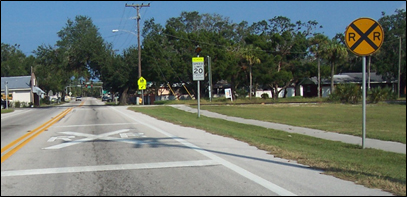 Railroad Crossing Signs, Signals, and Gates: The round, yellow RXR sign is an advance warning sign indicating a railroad crossing ahead. RXR pavement markings are followed by a stop line closer to the tracks.
Railroad Crossing Signs, Signals, and Gates: The round, yellow RXR sign is an advance warning sign indicating a railroad crossing ahead. RXR pavement markings are followed by a stop line closer to the tracks.
 The cross-buck sign marks the railroad crossing. The number of tracks may be shown below the cross-buck. Treat this as a yield sign.
The cross-buck sign marks the railroad crossing. The number of tracks may be shown below the cross-buck. Treat this as a yield sign.
At many highway-rail intersections, the cross-buck sign may incorporate a flashing red light and bell. When the lights begin to flash, you must stop. Treat this as a stop sign.
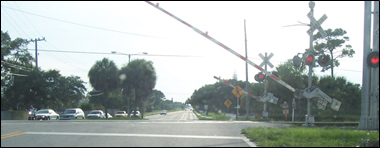 Many railroad crossings include gates as well as lights. If a railroad crossing gate is down, the road is closed. It is against the law to drive around or under a railroad crossing gate when it is down, or being lowered or raised. (s. 316.1575, F.S.)
Many railroad crossings include gates as well as lights. If a railroad crossing gate is down, the road is closed. It is against the law to drive around or under a railroad crossing gate when it is down, or being lowered or raised. (s. 316.1575, F.S.)
Railroad crossing signs, signals, and gates must be obeyed. Any person driving a vehicle (or walking) and approaching a railroad-highway crossing shall stop if any of the following conditions exist (s. 316.1575, F.S.):
- Red lights are flashing.
- A railroad crossing gate is down, or being raised or lowered.
- An approaching train emits an audible signal or is an immediate hazard.
- An approaching train is plainly visible and is in hazardous proximity to the railroad-highway crossing, regardless of the type of traffic control devices installed at the crossing.
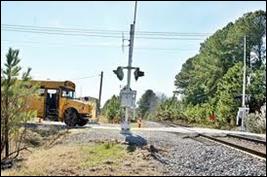 Once the train has passed, the light signals have stopped flashing, and the crossing gate has been fully raised, drivers may proceed after checking for additional trains. Before proceeding, be sure that there is enough room between you and any vehicles ahead to fully cross the tracks. Be cautious if following a school bus, vehicles carrying passengers for hire (excluding taxi cabs), or vehicles carrying explosive substances or flammable liquids as they are required to stop before all railroad tracks, even if a train is not approaching. If your vehicle stalls on railroad tracks, get yourself and your passengers out immediately. If a train is approaching, move away from the tracks and toward the oncoming train, away from the impending crash site. (s. 316.159, F.S.)
Once the train has passed, the light signals have stopped flashing, and the crossing gate has been fully raised, drivers may proceed after checking for additional trains. Before proceeding, be sure that there is enough room between you and any vehicles ahead to fully cross the tracks. Be cautious if following a school bus, vehicles carrying passengers for hire (excluding taxi cabs), or vehicles carrying explosive substances or flammable liquids as they are required to stop before all railroad tracks, even if a train is not approaching. If your vehicle stalls on railroad tracks, get yourself and your passengers out immediately. If a train is approaching, move away from the tracks and toward the oncoming train, away from the impending crash site. (s. 316.159, F.S.)
PAVEMENT MARKINGS
Pavement markings are used to control traffic on the roadways and must be obeyed, just as if they were road signs. Four colors are used for pavement markings: yellow, white, red, and blue.3,6,9
Yellow Lines are used to separate opposite-direction traffic:
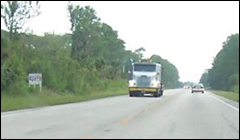 Broken Yellow Lines: Broken yellow lines separate traffic moving in opposite directions on two-lane roads. Stay to the right of the line, unless you are passing a vehicle in front of you. When passing, you may cross this line temporarily when it is safe to do so.
Broken Yellow Lines: Broken yellow lines separate traffic moving in opposite directions on two-lane roads. Stay to the right of the line, unless you are passing a vehicle in front of you. When passing, you may cross this line temporarily when it is safe to do so.
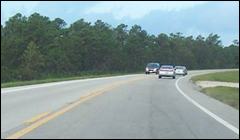 Solid Yellow Line combined with Broken Yellow Lines: If the solid yellow line is nearest to you, you are not permitted to pass. However, you are permitted to cross the solid yellow line when turning left after yielding to oncoming traffic. If the broken yellow line is nearest to you, you may cross the broken yellow line to pass when it is safe to do so.
Solid Yellow Line combined with Broken Yellow Lines: If the solid yellow line is nearest to you, you are not permitted to pass. However, you are permitted to cross the solid yellow line when turning left after yielding to oncoming traffic. If the broken yellow line is nearest to you, you may cross the broken yellow line to pass when it is safe to do so.
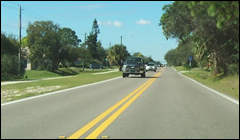 Double Solid Yellow Lines: These lines separate opposite-direction traffic on multi-lane highways as well as on two-lane roads. Crossing the lines is permitted only when making a left turn when it is safe to do so and after yielding to oncoming traffic.
Double Solid Yellow Lines: These lines separate opposite-direction traffic on multi-lane highways as well as on two-lane roads. Crossing the lines is permitted only when making a left turn when it is safe to do so and after yielding to oncoming traffic.
- Single Yellow Lines: These lines are used to mark the left edge of one-way highways and ramps.
White Lines that are parallel to traffic separate traffic going in the same direction:
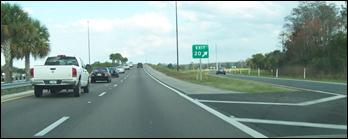 Broken White Lines separate lanes of traffic moving in the same direction. These lines may be crossed when you change lanes.
Broken White Lines separate lanes of traffic moving in the same direction. These lines may be crossed when you change lanes.
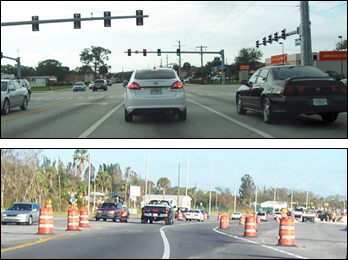 Solid White Lane Lines: A solid white line is used to mark the right edge of the pavement. Also, solid white lane lines are used to indicate that you should stay in your lane as you are entering an area where leaving your lane could cause a hazard. For example, solid white lines may be used prior to intersections or in construction zones as changing lanes in these areas can be very dangerous.
Solid White Lane Lines: A solid white line is used to mark the right edge of the pavement. Also, solid white lane lines are used to indicate that you should stay in your lane as you are entering an area where leaving your lane could cause a hazard. For example, solid white lines may be used prior to intersections or in construction zones as changing lanes in these areas can be very dangerous.
 Solid White Lines are also used to indicate pedestrian crosswalks and stop lines at intersections.
Solid White Lines are also used to indicate pedestrian crosswalks and stop lines at intersections.
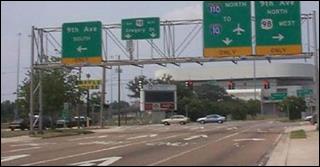 White Arrows: White arrows are used to control traffic. If you are in a lane marked with a curved arrow and the word ONLY, you must turn in the direction of the arrow. If your lane is marked with both a curved and straight arrow, you may either turn or go straight.
White Arrows: White arrows are used to control traffic. If you are in a lane marked with a curved arrow and the word ONLY, you must turn in the direction of the arrow. If your lane is marked with both a curved and straight arrow, you may either turn or go straight.
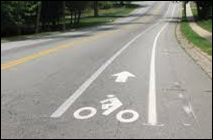 White lines are used to designate bicycle lanes on the right side of the roadway. It is illegal to drive in a lane designated for bicycle riding. (s. 316.1995, F.S.)
White lines are used to designate bicycle lanes on the right side of the roadway. It is illegal to drive in a lane designated for bicycle riding. (s. 316.1995, F.S.)

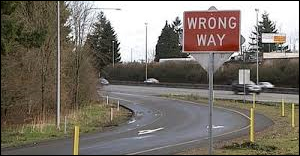 Red raised pavement markers are used to indicate one way roadways and ramps that shall not be entered or used.
Red raised pavement markers are used to indicate one way roadways and ramps that shall not be entered or used.
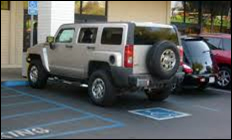 Blue markings are used to indicate parking spaces for disabled persons.
Blue markings are used to indicate parking spaces for disabled persons.
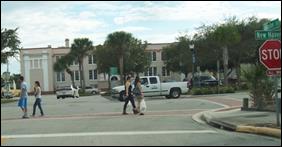 Crosswalks: While all pedestrians are vulnerable, children, the elderly, and those with disabilities are especially vulnerable. Florida law specifies that a person propelling a vehicle by human power (like a bicyclist, skater, or skateboarder) is considered to be a pedestrian if that person is in a crosswalk. If a pedestrian is in a crosswalk, even on the far side of the crosswalk, drivers approaching the crosswalk must stop regardless of the color of the traffic signal or the type of sign at the intersection. In this case, stop well back from the crosswalk so other vehicles will have an opportunity to see the pedestrians in the crosswalk as well. Never pass vehicles stopped for pedestrians in a crosswalk. Also, at intersections, motorists going straight ahead, or turning, must yield to pedestrians within the intersection. (s. 316.075, F.S.; s. 316.130, F.S.; s. 316.2065, F.S.)
Crosswalks: While all pedestrians are vulnerable, children, the elderly, and those with disabilities are especially vulnerable. Florida law specifies that a person propelling a vehicle by human power (like a bicyclist, skater, or skateboarder) is considered to be a pedestrian if that person is in a crosswalk. If a pedestrian is in a crosswalk, even on the far side of the crosswalk, drivers approaching the crosswalk must stop regardless of the color of the traffic signal or the type of sign at the intersection. In this case, stop well back from the crosswalk so other vehicles will have an opportunity to see the pedestrians in the crosswalk as well. Never pass vehicles stopped for pedestrians in a crosswalk. Also, at intersections, motorists going straight ahead, or turning, must yield to pedestrians within the intersection. (s. 316.075, F.S.; s. 316.130, F.S.; s. 316.2065, F.S.)
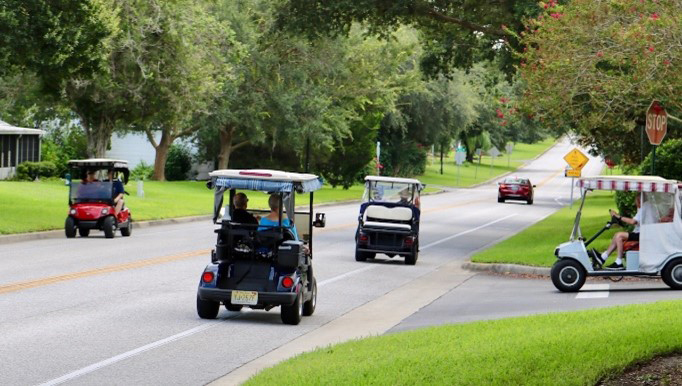 Operation of a Golf Cart: The operation of a golf cart upon the public roads or streets of Florida is prohibited except when approved by the government agency responsible for those roads or streets. Violation of this law is a moving violation, and a fine and points will be assessed to the person’s driver license. When the operation of golf carts on roadways is approved by the responsible government agency, a person under 18 years of age is prohibited from operating a golf cart unless he or she possesses a valid leaner’s license or valid driver license. Also, a person age 18 or older is prohibited unless he or she possesses a valid form of government-issued photographic identification. (s. 316.212, F.S.)
Operation of a Golf Cart: The operation of a golf cart upon the public roads or streets of Florida is prohibited except when approved by the government agency responsible for those roads or streets. Violation of this law is a moving violation, and a fine and points will be assessed to the person’s driver license. When the operation of golf carts on roadways is approved by the responsible government agency, a person under 18 years of age is prohibited from operating a golf cart unless he or she possesses a valid leaner’s license or valid driver license. Also, a person age 18 or older is prohibited unless he or she possesses a valid form of government-issued photographic identification. (s. 316.212, F.S.)
Driver Distraction
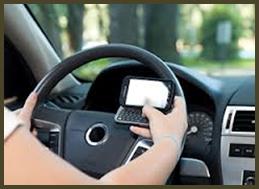 In addition to speeding and driving while impaired, driver distraction is a major safety problem. According to the National Highway Traffic Safety Administration (NHTSA), “the primary responsibility of the driver is to operate a motor vehicle safely. The task of driving requires full attention and focus.” This statement by the NHTSA is exactly right. When you are behind the wheel, you must focus on driving. Any activity that distracts a driver increases danger and risk. The NHTSA estimates that distraction is a factor in 25% of crashes reported by police.10
In addition to speeding and driving while impaired, driver distraction is a major safety problem. According to the National Highway Traffic Safety Administration (NHTSA), “the primary responsibility of the driver is to operate a motor vehicle safely. The task of driving requires full attention and focus.” This statement by the NHTSA is exactly right. When you are behind the wheel, you must focus on driving. Any activity that distracts a driver increases danger and risk. The NHTSA estimates that distraction is a factor in 25% of crashes reported by police.10
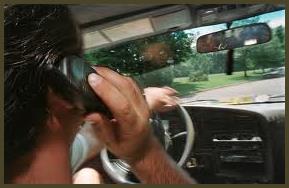 Drivers can be distracted visually or mentally, and most distractions involve a combination of these factors as our minds control where our eyes are looking. If your eyes or your mind are distracted from your driving, the risk that you will be involved in a crash goes up dramatically. Visual distractions, such as dialing your cell phone, texting, or tuning the radio, take your eyes off the road. Likewise, mental distractions, such as talking on your cell phone or having a conversation with friends in your vehicle, take your mind away from the driving task.11
Drivers can be distracted visually or mentally, and most distractions involve a combination of these factors as our minds control where our eyes are looking. If your eyes or your mind are distracted from your driving, the risk that you will be involved in a crash goes up dramatically. Visual distractions, such as dialing your cell phone, texting, or tuning the radio, take your eyes off the road. Likewise, mental distractions, such as talking on your cell phone or having a conversation with friends in your vehicle, take your mind away from the driving task.11
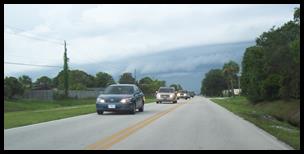 If you need to do something that will take your eyes off the road ahead, make sure you are not approaching a potentially dangerous situation that will require your full attention. Many drivers impulsively take their eyes off the road to answer cell phone calls or to change radio stations, regardless of the driving situation ahead. Make sure the roadway ahead is safe before you briefly take your eyes off the road, and always assume the situation ahead can change quickly. For example, if you are on a two-lane road with vehicles approaching in the opposite lane, keep your eyes on the road until the vehicles have passed by. If you are about to drive through an intersection or are approaching a bicycle rider, delay changing the radio station until it is safe to briefly take your eyes off the road.
If you need to do something that will take your eyes off the road ahead, make sure you are not approaching a potentially dangerous situation that will require your full attention. Many drivers impulsively take their eyes off the road to answer cell phone calls or to change radio stations, regardless of the driving situation ahead. Make sure the roadway ahead is safe before you briefly take your eyes off the road, and always assume the situation ahead can change quickly. For example, if you are on a two-lane road with vehicles approaching in the opposite lane, keep your eyes on the road until the vehicles have passed by. If you are about to drive through an intersection or are approaching a bicycle rider, delay changing the radio station until it is safe to briefly take your eyes off the road.
 First and foremost, you should work to reduce visual distractions, but if you must look away from the road ahead, you should always use the “one second rule.” If you must participate in a distracting activity, try not to look away from the road ahead for more than one second. Every time you look away from the road, count “one thousand one” and then get your eyes back on the road. Following this rule requires conscious effort, self-discipline, and self-awareness.
First and foremost, you should work to reduce visual distractions, but if you must look away from the road ahead, you should always use the “one second rule.” If you must participate in a distracting activity, try not to look away from the road ahead for more than one second. Every time you look away from the road, count “one thousand one” and then get your eyes back on the road. Following this rule requires conscious effort, self-discipline, and self-awareness.
Developing a mental one second timer takes training. Periodically, make one second training the focus of a trip in your vehicle. During this training trip, work very hard to be aware each time you take your eyes off the roadway ahead, and each time you do, be sure to use the one second rule.
 While drivers should attempt to remain focused on the driving task, there are many distractions that can divert a driver’s eyes and brain from that task. When behind the wheel, the use of hand-held electronic devices, like cell phones, should be avoided. The U.S. Department of Transportation is so concerned about distracted driving that it has called for a federal law to ban talking and texting on the cell phone while driving. Already, the majority of states have passed laws banning or restricting the use of electronic devices while driving. The National Highway Traffic Safety Administration believes that the use of cell phones while driving delays reaction time as much as having a Blood Alcohol Level of .08.12
While drivers should attempt to remain focused on the driving task, there are many distractions that can divert a driver’s eyes and brain from that task. When behind the wheel, the use of hand-held electronic devices, like cell phones, should be avoided. The U.S. Department of Transportation is so concerned about distracted driving that it has called for a federal law to ban talking and texting on the cell phone while driving. Already, the majority of states have passed laws banning or restricting the use of electronic devices while driving. The National Highway Traffic Safety Administration believes that the use of cell phones while driving delays reaction time as much as having a Blood Alcohol Level of .08.12
The visual and mental distraction caused by making and answering cell phone calls greatly increases the danger associated with driving. Likewise, talking on the cell phone is dangerous as this activity distracts our minds from the tasks associated with driving.11,13
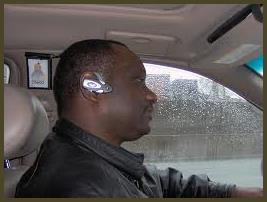 Research indicates that cell phone use, including both hand-held and hands-free phones, distracts driver attention and has a negative effect on driving performance. We want to emphasize that hands-free cell phones do not eliminate the distraction problem associated with cell phone usage. Also, it appears that talking on a cell phone is more dangerous than talking to a passenger. The National Highway Traffic Safety Administration stresses that while an alert passenger can be aware of the driving situation and can warn you of potential danger, the person on the other end of a cell phone call has no idea about your driving situation.10
Research indicates that cell phone use, including both hand-held and hands-free phones, distracts driver attention and has a negative effect on driving performance. We want to emphasize that hands-free cell phones do not eliminate the distraction problem associated with cell phone usage. Also, it appears that talking on a cell phone is more dangerous than talking to a passenger. The National Highway Traffic Safety Administration stresses that while an alert passenger can be aware of the driving situation and can warn you of potential danger, the person on the other end of a cell phone call has no idea about your driving situation.10
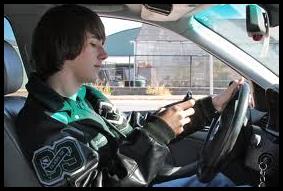 Texting is incredibly dangerous. In one recent case in Florida, a driver looked down to read a text message while crossing a bridge. This distraction caused the driver to veer off the right side of the road where he struck and killed two young men who were fishing.14
Texting is incredibly dangerous. In one recent case in Florida, a driver looked down to read a text message while crossing a bridge. This distraction caused the driver to veer off the right side of the road where he struck and killed two young men who were fishing.14
The “Florida Ban on Texting While Driving Law” makes texting while operating a motor vehicle illegal. This violation is a primary offense, which means that a citation for texting can be issued if texting is the only traffic law violation. Texting law violations will be punished as moving violations, and three points will be assessed. According to this law, a person may not operate a motor vehicle while:
- Typing/entering multiple letters, numbers, symbols, or characters into a wireless communications device.
- Sending or reading data on a wireless communications device for the purpose of non-voice interpersonal communication. This includes, but is not limited to, texting, e-mailing, and instant messaging.
The term “wireless communications device” means any handheld device used or capable of being used in a handheld manner that is designed or intended to receive or transmit text or character-based messages, access or store data, or connect to the internet or other communications service.
If the motor vehicle is not moving, the driver is not considered to be operating the vehicle, and the prohibitions regarding texting do not apply.
In the event of a crash resulting in death or personal injury, a driver’s billing records for a wireless communications device or testimony or written statements from appropriate authorities receiving such messages may be admissible as evidence in any proceeding to determine if the texting law has been violated. (s. 316.305, F.S.)
It is illegal to operate a motor vehicle while using a wireless communications device in a handheld manner in a designated school crossing, school zone, or work zone if workers are present or operating equipment. The term wireless communications device is described above and includes, but is not limited to, a cell phone, tablet, laptop, two-way messaging device, or electronic game used or capable of being used in a handheld manner. A vehicle that is not moving is not subject to this law. (s. 316.306, F.S.)
Do not use your cell phone and do not text while driving.
Information on motorcycle licensing and training.
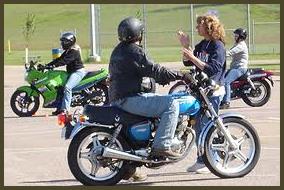 The Department of Highway Safety and Motor Vehicles (DHSMV) has established the Florida Motorcycle Safety Education Program. All first-time applicants for a motorcycle license, regardless of age, must attend a motorcycle safety course that is approved by the DHSMV. This course includes 12 hours of instruction, including 6 hours of actual motorcycle operation. (s. 322.0255, F.S.; s. 322.12, F.S.)
The Department of Highway Safety and Motor Vehicles (DHSMV) has established the Florida Motorcycle Safety Education Program. All first-time applicants for a motorcycle license, regardless of age, must attend a motorcycle safety course that is approved by the DHSMV. This course includes 12 hours of instruction, including 6 hours of actual motorcycle operation. (s. 322.0255, F.S.; s. 322.12, F.S.)
Possession of a standard driver’s license does not authorize you to operate a motorcycle. If you already have a driver’s license and want to operate a motorcycle, you must complete the motorcycle safety course and take an examination for motorcycle operators. This examination includes a written test and a riding demonstration of your ability to safely operate a motorcycle. After successful completion of this examination, the department will indicate on your driver’s license that you are also authorized to operate a motorcycle. (s. 322.12, F.S.)
If you wish to be licensed to operate a motorcycle only, you must first take the motor vehicle operator’s written examination, but you are not required to take the road test. You must then complete the motorcycle safety course, including the written exam and riding demonstration. After successful completion of this examination, the department will indicate on your driver’s license that you are restricted to operating a motorcycle only. (s. 322.12, F.S.)
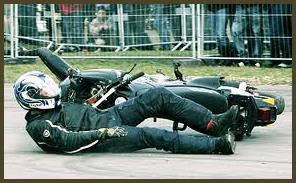 In Florida, a motorcycle operator or passenger must wear protective headgear, unless the operator or passenger is over 21 years of age and is covered by an insurance policy that would provide $10,000 in medical payments if the operator or passenger is injured in a crash. Also, the motorcycle operator must wear an eye-protection device. Headgear and eye-protection devices must meet standards set by the DHSMV. Violation of these laws is a non-moving violation. Finally, to reduce injury and to improve the likelihood of survival in a crash, motorcycle riders should wear proper protective clothing. (s 316.211, F.S.)
In Florida, a motorcycle operator or passenger must wear protective headgear, unless the operator or passenger is over 21 years of age and is covered by an insurance policy that would provide $10,000 in medical payments if the operator or passenger is injured in a crash. Also, the motorcycle operator must wear an eye-protection device. Headgear and eye-protection devices must meet standards set by the DHSMV. Violation of these laws is a non-moving violation. Finally, to reduce injury and to improve the likelihood of survival in a crash, motorcycle riders should wear proper protective clothing. (s 316.211, F.S.)
General importance of vehicle safety maintenance (including the dangers of carbon monoxide poisoning).
No matter how much you know about safe driving and how disciplined you are in following safe driving guidelines, if your vehicle is not in good condition, you are not safe in operating your vehicle. You should refer to your vehicle owner’s manual to determine how to check safety items. Inspecting your vehicle for safety can save money and your life.3
Drivers should periodically check the following items, and problems should be corrected:3,4,6,15,16,17
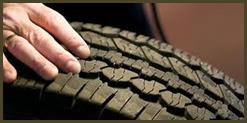 Tires: Check them before driving. Your tires are critical to the safe operation of your vehicle.
Tires: Check them before driving. Your tires are critical to the safe operation of your vehicle.- Tires should not be worn. Between the grooves in the treads of your tires, the tire manufacturer has placed tire wear indicators. If your tire wears down so the tread is even with the tire wear indicators, your tire is no longer legal to operate on our roadways. Also, the cords on your tires should never be visible, there should be no bulges or bald spots, and there should be no items imbedded in your tires.
- Proper tire inflation is vital in preventing blowouts and ensuring optimum tire performance. To determine the tire pressure recommended by the manufacturer of your vehicle, check the owner’s manual or the tire information placard that may be located on the door post, door edge, glove compartment, or trunk lid. Use the recommended tire pressure on the placard rather than the maximum permissible inflation pressure which is printed on the side of the tire.
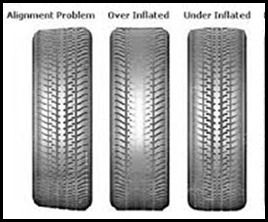 If your tires are under inflated, they are more likely to heat up and blow out when driving, and they will wear on the outer edges as the weight of your vehicle is being carried by the outer edges of your tires. If your tires are over inflated, they will wear in the center as the weight of your vehicle is being carried by the center of your tires. If the weight of your vehicle is not distributed evenly across your tires, you will experience uneven tire wear and less-than-optimum braking and cornering performance.
If your tires are under inflated, they are more likely to heat up and blow out when driving, and they will wear on the outer edges as the weight of your vehicle is being carried by the outer edges of your tires. If your tires are over inflated, they will wear in the center as the weight of your vehicle is being carried by the center of your tires. If the weight of your vehicle is not distributed evenly across your tires, you will experience uneven tire wear and less-than-optimum braking and cornering performance.- If your tires are not properly aligned, they are not rolling straight down the roadway, and this may cause your vehicle to pull to one side. With improper alignment, your tires will also show excessive wear on one edge.
- Also, tire balance should be checked if your vehicle pulls to one side, if you experience vibration when driving, or if tire wear is uneven.
- You should rotate your tires periodically as this will prolong the life of your tires.
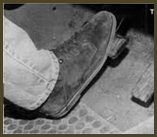 Brakes: Check your brakes immediately each time you begin driving. The brake warning light should not be illuminated, the brake pedal should feel firm and not spongy, the vehicle should stop smoothly without pulling to one side or grabbing, and you should not hear scraping sounds when you apply your brakes. If you experience any of these problems, you should immediately have your brakes checked by a mechanic.
Brakes: Check your brakes immediately each time you begin driving. The brake warning light should not be illuminated, the brake pedal should feel firm and not spongy, the vehicle should stop smoothly without pulling to one side or grabbing, and you should not hear scraping sounds when you apply your brakes. If you experience any of these problems, you should immediately have your brakes checked by a mechanic.
- Fluid Levels: Before driving, check for fluids on the ground under your vehicle. Periodically check the following vehicle fluids:
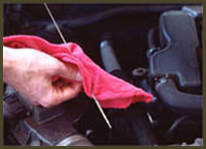 Oil – Check that your oil level is within normal limits when your engine is cool and not running. Change oil in accordance with guidance in your owner’s manual.
Oil – Check that your oil level is within normal limits when your engine is cool and not running. Change oil in accordance with guidance in your owner’s manual.- Transmission Fluid – Check that the fluid level is within normal limits. Change fluid in accordance with guidance in your owner’s manual.
- Cooling Liquid in your Radiator Overflow Tank or Radiator – Check your cooling fluid level when the engine and coolant are cool.
- Brake Fluid – Check that the brake fluid level is within normal limits. If you find that your brake fluid is low, add brake fluid and closely monitor your brake fluid level as low fluid levels may be an indication that you have a leak in your brake system that could lead to a complete brake failure. If the fluid level continues to be low, have a mechanic check your brake system.
- Power Steering Fluid – Check that the fluid level is within normal limits.
- Window Washer Fluid – Check that the fluid level is adequate.
The following are some additional items drivers should periodically check and correct if there are any problems:
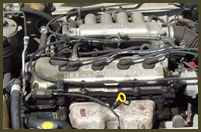 Engine Belts, Hoses, and Wiring: Belts should be tight and should not be frayed or cracked. Hoses should not have leaks, cracks, or bulges. Wiring should not be loose, broken, or disconnected. Insulation should not be cracked. Battery cables should be tightly connected and should not be corroded.
Engine Belts, Hoses, and Wiring: Belts should be tight and should not be frayed or cracked. Hoses should not have leaks, cracks, or bulges. Wiring should not be loose, broken, or disconnected. Insulation should not be cracked. Battery cables should be tightly connected and should not be corroded.- Lights and Turn Signals: All lights, including brake lights and turn signals, should be periodically checked. Have someone assist you when checking lights.
- Steering: Check immediately each time you begin driving. Your steering should feel smooth, and there should not be excessive play in the wheel. The steering system should not make noises when being operated, and there should be no shimmying, shaking or pulling to one side.
- Suspension Systems: Check that your vehicle rides smoothly, does not continue to bounce after going over a bump, and does not lean excessively when turning.
- Horn: Periodically check your horn. Make sure that you are aware of the position of the horn on your steering wheel.
- Windows and Windshield Wipers: Make sure that your windows are clean and that windshield wipers are not worn and do not leave streaks.
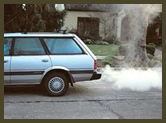 Exhaust System: A vehicle’s exhaust system must be in good working order and must not generate excessive or unusual noise. A vehicle’s engine must not emit excessive fumes or smoke. (s.316.272, F.S.)
Exhaust System: A vehicle’s exhaust system must be in good working order and must not generate excessive or unusual noise. A vehicle’s engine must not emit excessive fumes or smoke. (s.316.272, F.S.)
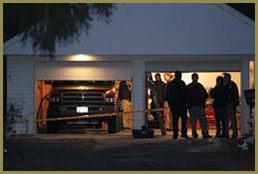 Your exhaust system emits carbon monoxide gas. Carbon monoxide is often called the silent killer because it is a colorless, odorless gas that can cause headache, nausea, dizziness, confusion, and ultimately, loss of consciousness and death. Never run a vehicle in a garage when the garage door is closed. Also, a leaking exhaust system can cause you to experience carbon monoxide poisoning when you are driving your vehicle. If you drive your vehicle with an open back window, carbon monoxide gas will be pulled into your vehicle unless you open other vents and windows to ensure that air flows out of, and not into, the back window.18
Your exhaust system emits carbon monoxide gas. Carbon monoxide is often called the silent killer because it is a colorless, odorless gas that can cause headache, nausea, dizziness, confusion, and ultimately, loss of consciousness and death. Never run a vehicle in a garage when the garage door is closed. Also, a leaking exhaust system can cause you to experience carbon monoxide poisoning when you are driving your vehicle. If you drive your vehicle with an open back window, carbon monoxide gas will be pulled into your vehicle unless you open other vents and windows to ensure that air flows out of, and not into, the back window.18
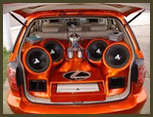 Noise: No person can operate a vehicle that generates excessive sound. Also, it is illegal to operate radios, tape players, or other sound making devices so they are plainly audible from a distance of 25 feet. (s.316.293, F. S.; s.316.3045(1)(a), F.S.)
Noise: No person can operate a vehicle that generates excessive sound. Also, it is illegal to operate radios, tape players, or other sound making devices so they are plainly audible from a distance of 25 feet. (s.316.293, F. S.; s.316.3045(1)(a), F.S.)
REVIEW QUESTIONS FOR SECTION 10
The Section Review Questions will help to prepare you for the Final Exam; incorrect answers will not count against you. You must complete the Section Review Questions before moving on to the next section of the course.
0
1. U.S. Department of Transportation, National Highway Traffic Safety Administration’s National Center for Statistics and Analysis. Traffic Safety Facts, 2021 Data: Summary of Motor Vehicle Traffic Crashes. DOT HS 813 515. Available at: http://www-nrd.nhtsa.dot.gov/Pubs/813515.pdf. Retrieved July 21, 2024.
2. U.S. Department of Transportation, National Highway Traffic Safety Administration’s National Center for Statistics and Analysis. Traffic Safety Facts, 2022 Data: Speeding. DOT HS 813 582. Available at: http://www-nrd.nhtsa.dot.gov/Pubs/813582.pdf. Retrieved July 21, 2024.
3. American Automobile Association (AAA). Responsible Driving. McGraw-Hill Education, March 7, 2005, pp 77-92, 103-105, 316-318, 328-332.
4. American Automobile Association (AAA). How to Drive: The Beginning Driver’s Manual. 14th edition, pp 27, 259-261.
5. American Automobile Association (AAA). Safe Driving for Mature Operators. McGraw-Hill Education, 1998, pp 40.
6. Johnson M, Mottola F. Drive Right. Prentice-Hall, 2002, pp 20-34, 363-369.
7. American Automobile Association (AAA). School’s Open – Drive Carefully. Available at: http://exchange.aaa.com/safety/child-safety/schools-open-drive-carefully. Retrieved November 14, 2013.
8. American Automobile Association (AAA). AAA Urges Motorists to Drive Cautiously Around and Through Work Zones. Available at: http://newsroom.aaa.com/2011/04/2011-work-zone-awareness. Retrieved November 14, 2013.
9. U.S. Department of Transportation, Federal Highway Administration. Manual on Uniform Traffic Control Devices, 2009 Edition with Revision Numbers 1 and 2 incorporated, dated May 2012. Available at: http://mutcd.fhwa.dot.gov/pdfs/2009r1r2/pdf_index.htm. Retrieved November 14, 2013.
10. U.S. Department of Transportation, National Highway Traffic Safety Administration. NHTSA Policy and FAQs on Cellular Phone Use While Driving Policy Statement. Available at: http://www.gsa.gov/graphics/ogp/vv35Cell_Phone_Use_R2-y-mKM_0Z5RDZ-i34K-pR.doc&ei=1NKFUpKENOS02AWrqoHgBw&usg=AFQjCNEfuVPMrmKxzL7jeiDNTK-9nm0QAw&cad=rja. Retrieved November 14, 2013.
11. U.S. Department of Transportation, National Highway Traffic Safety Administration. The 100-Car Naturalistic Driving Study. DOT HS 810 593. Available at: http://www.distraction.gov/research/PDF-Files/The-100-Car-Naturalistic-Driving-Study.pdf. Retrieved November 15, 2013.
12. Forsyth J. “U.S. ban sought on cell phone use while driving.” Reuters, April 26, 2012. Available at: http://www.reuters.com/article/2012/04/27/usa-driving-idUSL2E8FQOK82012042. Retrieved November 16, 2013.
13. U.S. Department of Transportation, National Highway Traffic Safety Administration. Breakthrough Research on Real-World Driver Behavior Released, April 20, 2006. Available at: http://www.distraction.gov/content/press-release/2006/04-20.html. Retrieved April 24, 2013.
14. Barchenger S. “Mom of man killed on Eau Gallie bridge plans lawsuit.” Florida Today, October 18, 2013. Available at: http://www.floridatoday.com/article/20131018/NEWS01/310180018/Mom-man-killed-Eau-Gallie-bridge-plans-lawsuit?nclick_check=1. Retrieved November 16, 2013.
15. American Automobile Association (AAA). Signs of Tire Wear. Available at: http://www.autoclubmo.aaa.com/automotive/maintain/repair/tires_wear.html. Retrieved November 16, 2013.
16. U.S. Department of Transportation, National Highway Traffic Safety Administration. Tire Safety: Everything Rides On It. DOT HS 809 361. Available at: http://www.nhtsa.gov/cars/rules/tiresafety/ridesonit/brochure.html. Retrieved November 16, 2013.
17. U.S. Department of Transportation, National Highway Traffic Safety Administration. Federal Motor Vehicle Safety Standards; Tire Pressure Monitoring Final Rule (Part III). 49 CFR Part 571. Available at: http://www.nhtsa.gov/cars/rules/rulings/tirepresfinal/safetypr.html. Retrieved November 16, 2013.
18. Centers for Disease Control and Prevention. Carbon Monoxide Poisoning: Frequently Asked Questions. Available at: http://www.cdc.gov/co/faqs.htm. Retrieved November 16, 2013.
Florida Statutes, s. 316, 318, 322, 626.
